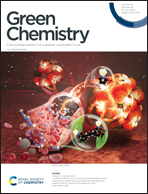Structure–activity relationships of LDH catalysts for the glucose-to-fructose isomerisation in ethanol†
Abstract
Glucose-to-fructose isomerization is the key process in the reaction sequence that can lead to the total conversion of biomass into valuable fine chemicals. However, it is challenging to find an efficient, cost-effective- and waste-minimized process to produce High Fructose Corn Syrup (HFCS) without using non-green approaches. To this end, hydrotalcite (MgAl-layered double hydroxides (MgAl-LDH)) catalyzed glucose isomerization in ethanol seemed to be one of the most promising processes in the last decade. In contrast to the well-studied reaction carried out in aqueous solutions, when ethanolic solutions are used, many potentially important properties of the LDHs cannot be studied in terms of how they affect their own catalytic abilities. Neither the effect of the basic site distribution, nor the morphological aspects and the role of surface hydration have been elucidated so far. In this study, the systematic alteration of the textural and structural parameters of hydrotalcites and hydrocalumites (Ca2Al-LDH) revealed clear structure–activity-selectivity relationships. These indicate that the rate-determining factor is the hydrophilicity and the LDH surface factors affecting it, which determine the catalytic performance of the LDH catalyst more than any other factor. This is evidenced by the fact that the catalytic efficiency of hydrotalcites can be improved by reducing their basicity. When isomerizations catalyzed by the easily recyclable LDH with suitable surface features are carried out, a truly similar catalytic performance (71% glucose conversion, 83% fructose selectivity, 59% fructose yield) can be achieved as was previously described, but at a significantly lower reaction temperature (120 °C → 80 °C).



 Please wait while we load your content...
Please wait while we load your content...